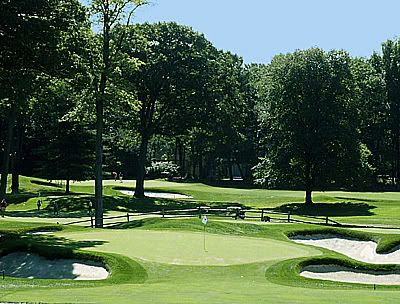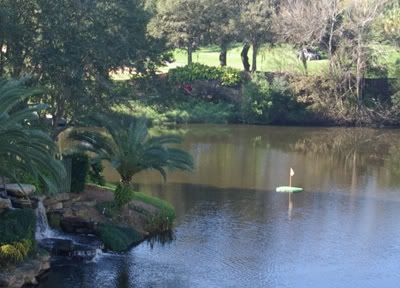
Dave Donelson, author of Heart of Diamonds a romantic thriller about blood diamonds in the Congo
“You have to contact the ball first before the sand, so you get it to the green,” he answered more seriously. I noted that this is absolutely opposite to what you’re supposed to do in a green-side bunker and he agreed. He choked up a full hand-width from the end of the club and said, “Play the ball back in your stance, grip down, and take a little extra club so you can take a smoother swing.”I’ve heard that smooth swing mantra before. It’s hard to do when you’re standing in kitty litter and your buddies are snickering from the sidelines because they know you don’t have a clue how hard to hit the ball to make it reach the green without sailing over it.
 Here's some new golf technology for you: PowerBilt is filling the head of a golf club with nitrogen gas. NO, it doesn't sound like a Whoopee Cushion when you hit it and NO it doesn't explode--although the company says the idea is to get explosive power off the tee.
Here's some new golf technology for you: PowerBilt is filling the head of a golf club with nitrogen gas. NO, it doesn't sound like a Whoopee Cushion when you hit it and NO it doesn't explode--although the company says the idea is to get explosive power off the tee.
“The finest thing The Saint Andrew’s Golf Club did in starting the game of golf was...that they started it right, with the right traditions,” said legendary champion Bobby Jones.Saint Andrew’s has a rich history, including it's role as a founding member of the United States Golf Association (USGA) in December 1894. The club also hosted the first unofficial U.S. Amateur as well as the first “open” championship.

 Rob Labritz has been crowned “Player of the Year” by the ultra-competitive Metropolitan Section of the PGA. Labritz, the Director of Golf at Bedford, NY's GlenArbor Golf Club won the singular honor with a stellar season of competition against a group of what are arguably the strongest group of club pros in the country's 41 PGA Sections.
Rob Labritz has been crowned “Player of the Year” by the ultra-competitive Metropolitan Section of the PGA. Labritz, the Director of Golf at Bedford, NY's GlenArbor Golf Club won the singular honor with a stellar season of competition against a group of what are arguably the strongest group of club pros in the country's 41 PGA Sections.“This win is a product of hard work and dedication. I’ve been working for it all year long. Day after day, I spent countless hours at GlenArbor’s Short Game Center practicing every possible shot from within 125 yards of the pin, chipping and putting. I am very fortunate to have access to such incredible facilities.”Labritz and the GlenArbor Short Game Center was featured in an article I wrote a couple of years ago for Westchester Magazine.
"There are many similarities in management and golf, as well as in teaching management and golf," said Montana. "Both require strategic thinking, planning, execution, control, evaluation and feedback. Given golf's popularity and global reach as well as its multibillion dollar market, we are constantly seeking ways to nurture this vibrant sport and make it and our business more efficient and effective."Now, if he could just manage my putting stroke....
 James Patterson said it best, “You like golf, you like murder mysteries, then Sudden Death is your book."
James Patterson said it best, “You like golf, you like murder mysteries, then Sudden Death is your book." 
"Following our experience at the 2007 U.S. Amateur sectional qualifying round, it became obvious that the challenge, the beauty and the location of Anglebrook made it a perfect site for our Mid-Am."Anglebrook General Manager Matt Sullivan says the club is honored to join the list of prestigious sites chosen by the MGA for one of its premiere events.
--Gene Westmoreland, MGA Tournament Director


 It turns out that at least part of the problem is the clubs. Grosz explained that, once the basic lie angle is determined by your body and your swing (which is what used to happen during a normal fitting), each one of a matched set of irons should have progressively shorter shafts (by a half-inch each) and a one-half degree more upright lie angle. When they measured my irons, some of them were as much as three times more upright than they should be.
It turns out that at least part of the problem is the clubs. Grosz explained that, once the basic lie angle is determined by your body and your swing (which is what used to happen during a normal fitting), each one of a matched set of irons should have progressively shorter shafts (by a half-inch each) and a one-half degree more upright lie angle. When they measured my irons, some of them were as much as three times more upright than they should be.

During the Old Course in Reverse event, golfers get to play the Old Course on its original clockwise routing starting from the first tee and playing to the 17th green, then the 18th tee to the 16th green and so on.
The Old Course was played in this direction until the 1870s when Old Tom Morris created the present first green. This made it possible to play in the anti-clockwise direction. In fact, until the early 20th Century the course was played in both directions in alternate weeks.
Until the 1970s the course was set up in the clockwise direction for four weeks in the winter. St Andrews Links Trust, which manages and maintains the seven public courses in St Andrews including the Old Course and the
Dave Donelson, author of Heart of Diamonds a romantic thriller about blood diamonds in the Congo
“Look at Tiger and Ernie Els and all the rest, it might be 10% coaching and 90% perspiration, but they’re all taking lessons.”
“You can’t see yourself, so you don’t realize the balls back too far to forward too far, or your posture isn’t good, or your grip’s slipped, or you’re aiming to the right or left. Just different little things that all of us humans need some coaching with. Even Michael Jordan had good coaching.”
So next time you're handing over $500 for the latest can't-miss driver, consider handing $50 to your local PGA professional instead. The odds are much better than ten to one that he or she will straighten out your drive a lot quicker than that shiny new chunk of titanium.Doral's Blue Monster, home of the WGC CA Championship, is one the great classic Florida courses you can play. But if you go, make sure you stay an extra day to check out the other monster at the resort, the Great White Course.
The Great White Course is arguably the Blue Monster’s equal although Greg Norman’s design makes it a totally different golf experience in several ways. At 6,679 yards, the Great White is about the same length as the Blue Monster although fewer of the greens are elevated, so it doesn’t play quite as long. You need a wide variety of approach shots, though—from high soft short irons over trouble to laser-guided long irons or hybrids, so it’s more entertaining that it’s more famous sibling in many ways.
The course had a reputation for undue toughness for a few years, but the Great White was made much more playable with a major remodeling in 2006, according to Golf General Manger Darrin Helfrick. They took out 125 pot bunkers and re-contoured the crowned green on the 6th hole—although it’s still harder to hit than a flea’s butt with a BB gun at 149 yards.
The course also technically has no rough, but don’t let that fool you. The short grass runs right into fairway-defining waste areas dotted with saw grass, trees, and other ball-blocking vegetation. And, because there’s generally no long grass to stop it, an errant shot may run a long, long way on the hard coquina sand in the waste areas. They also slip quite easily into bunkers and water hazards, so you have to plan not just the direction but the distance of your shots with care.
The Great White offers an excellent mix of demanding holes. There’s the 577-yard 14th that’s a four-shot hole for most golfers when it plays into the wind, the 161-yard island green 8th hole, and the 374-yard 10th, where a wide but shallow green forces you to lob a high, soft approach exactly the perfect distance—three steep bunkers guard the front while water awaits just off the back edge. The first and last holes are reachable par fives, too, depending on the wind, which makes for some interesting matches.
Dave Donelson, author of Heart of Diamonds a romantic thriller about blood diamonds in the Congo
Winged Foot’s West Course is just one of the 50 elite courses profiled by White Plains, NY golf writer David Barrett in this stunning large-format volume. Barrett was features editor of Golf Magazine for 18 years and knows whereof he writes. In addition to Pebble Beach, Oakmont, and Pinehurst #2, Barrett also introduces the golf-addicted reader to some lesser-known sites from the early history of the tournament such as Myopia Hunt Club and Inwood Country Club.
Barrett’s narrative includes an immense amount of detail about each course’s history and design as well as numerous anecdotes about the great (and not-so-great) players of the game. There’s also a foreword by Rees Jones, who is known as the “Open Doctor” for his architectural work on many US Open courses.
Dave Donelson, author of Heart of Diamonds a romantic thriller about blood diamonds in the Congo